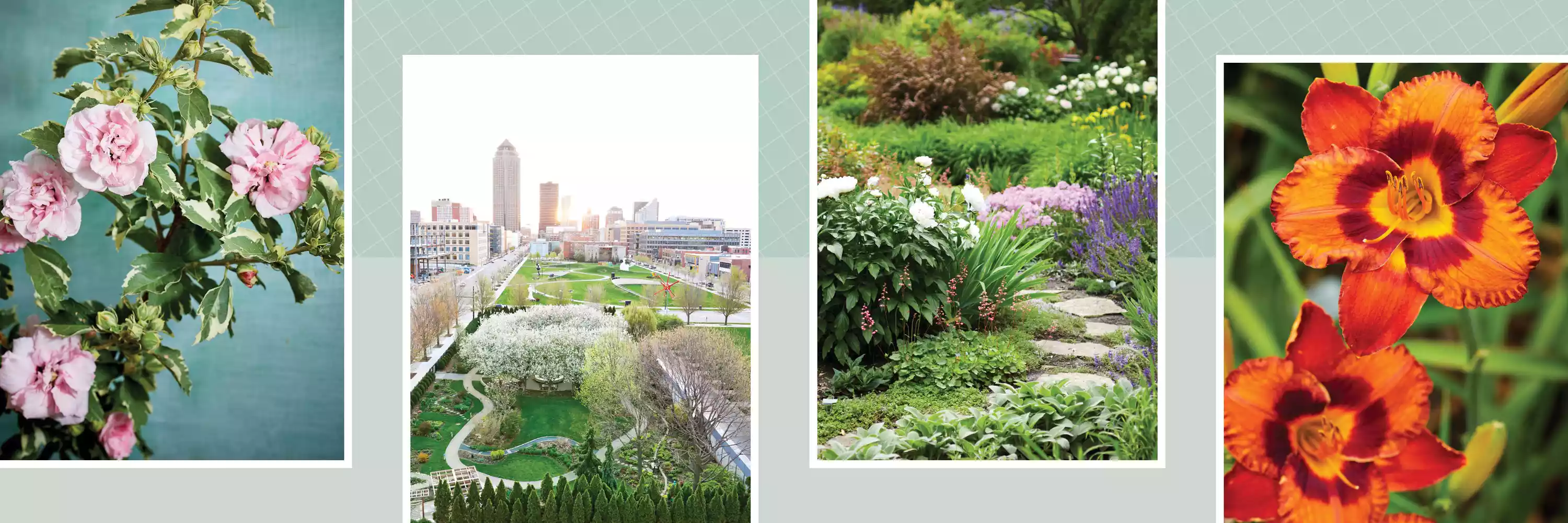Tall green arborvitaes stand sentinel around the grounds of the picture-perfect Better Homes & Gardens Test Garden®, keeping watch over the half-acre space full of colorful plants and gardening inspiration. The bordering trees also muffle the sounds of traffic along the western gateway to downtown Des Moines, making the Test Garden an urban oasis adjacent to the Better Homes & Gardens (BHG) editorial offices. It’s hard to believe that this beautiful garden, which turns 25 this year, now thrives where an auto repair shop and a dry cleaner once stood.
According to former BHG garden editor Mark Kane, “The idea hit me one day that our magazine had a food department and a Test Kitchen where recipes were developed and tested for our readers,” says Kane. “I proposed the idea of creating an on-site test garden that could also serve as a photo studio.”
Kane created the Test Garden plan that launched the project. He also hired Sandra Gerdes away from the gardens of Disney World to manage the new Test Garden. Shortly after Gerdes arrived, Kane handed her “pages of blueprints and said ‘Here ya go.’” Gerdes laughs, recalling that day. “And we made a garden.”
:strip_icc():focal(1332x0:1334x2):format(webp)/BHG_Test_Garden_06_D7EPX1uFqWU9caeXTpWrRM-187b095a85c04d6da0cd3dffb3fdf83a.jpg)
:strip_icc():focal(1332x0:1334x2):format(webp)/BHG_Test_Garden_03_2MVcofGw4TD86Q7RjzYGzJ-2ca10ec56800427ba529b65ac1237881.jpg)
Carson Downing
Carson Downing
That's a bit of an understatement. The space grew into the stunning showpiece it is today, complete with 22 distinct garden areas that mimic various conditions and features of the typical home garden. A curving path weaves through a variety of landscapes and outdoor “rooms” surrounding a central courtyard complete with seating area and custom-made fountain.
In addition to well-established trees and shrubs, including roses and flowering crabapple trees, the Test Garden is dotted with newly introduced plants. There is a vegetable and herb garden and a shades-of-green hosta garden. There are perennials and annuals galore, providing color through the seasons. Container gardens flaunt grasses, striking foliage, and colorful flowers.
“Our first and foremost mission is to test plants for our readers,” says Gerdes. “We want to help them have better gardens.”
:strip_icc():focal(1332x0:1334x2):format(webp)/BHG_Test_Garden_07-8PdXskgEKWz8CCnL5GpUry-911ada7d932b4b20b4ff9e664cc84c2a.jpg)
:strip_icc():focal(621x792:623x794):format(webp)/bhg-test-garden-ChLvC5xC4L28_ubQu3pxDF-142003791fa744d7bc0e66f34fe12db9.jpg)
Greg Scheidemann
Our first and foremost mission is to test plants for our readers,” says Gerdes. “We want to help them have better gardens.
Sandra Gerdes
That mission hasn’t changed in 25 years. However, garden trends, methods, plants, and goals of home gardeners have evolved over the years. The Test Garden has evolved as well.
“We are always looking for good garden performers,” Gerdes says. “If it’s a sun plant, it better do well in the sun. If it’s a new variety, we look for disease resistance because we want to reduce the environmental impact of chemicals. If it has flowers, we test to see if it is long-blooming. Or is it fragrant?"
“We work with plant breeders, nurseries, and the whole green industry to get the latest and greatest introductions to test before they hit the retail market. We want to find the most garden-worthy plants to share with our readers.”
For Better Homes & Gardens, the Test Garden is a place of information gathering as well as inspiration, says Stephen Orr, editor in chief of BHG. In addition to sharing what’s new in the plant kingdom, Gerdes works with editors and photographers to make sure they are providing inspiration and tips and sits in on story planning meetings for all content platforms.
“Sandra keeps us up to date on what’s trending in commercial horticulture, and also we do our own tests,” Orr says. “We did a page a few years ago on which types of hostas can best withstand slugs, for example.”
:strip_icc():focal(1332x0:1334x2):format(webp)/ice-n-roses-red-hellebore-perennial-965205f5454846f69b524d3d0550ee99.jpg)
:strip_icc():focal(1499x0:1501x2):format(webp)/BHG_Cover_Jan_Feb_2022-1de0a8021fae46e78cbfa1157d411631.jpg)
Carson Downing
Better Homes & Gardens
In order to keep up to date on plants and gardening trends, the BHG Test Garden is constantly changing. “It’s the evolution of a living thing,” Gerdes says. “Things grow. Things die. Things get pulled out and replaced. We’ve lost plants and trees to storm damage or disease. We tweak beds and plant the newest vegetables and herbs for stories. We do what we can to help our readers make better gardens."
Like Gerdes, Doug Jimerson, a former BHG editor, has watched trends come and go over the past 25 years. Jimerson tested plants on his farm near Des Moines before the Test Garden was created. He’s noticed many positive changes home gardeners are adopting: gardening organically without herbicides or pesticides; landscaping with native plants; gardening for pollinators (bees, butterflies, bats, and birds) in mind; and raised bed and container gardening. And, he says, plant companies are constantly developing better plant varieties with home gardeners in mind.
“They want to insure gardeners have a more successful outcome,” Jimerson says. “You might not see the differences when you look at a plant in your local home store, but behind every new variety there's been years of research to make that plant work better for you. So, a red geranium may look a lot like the one you bought the year before, but the newer model may bloom longer and fuller and be more disease resistant.”
Jane Miller Kurns, who once served as deputy garden editor for Better Homes & Gardens, also has watched the garden evolve. “In 25 years, the garden has inspired countless features on the pages of magazine, enjoyed by loyal readers who have come to learn that gardening never goes out of style,” says Kurns.
“The best part of having the BHG Test Garden on site was its proximity. I loved having the ability to step out of my office any time of day to check on the progress of that season’s projects, whether it was a container garden story or a plant profile story,” she says. “Flowers don’t always bloom on cue, so keeping an eye on them daily helped us be more spontaneous with photography schedules. It always seemed as if Sandra had waved a magic wand over the garden to make the lighting perfect. Perhaps she learned that trick from her days at Disney.”




















